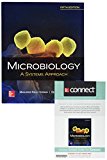
GEN COMBO LOOSELEAF MICROBIOLOGY:A SYSTEMS APPROACH; CONNECT ACCESS CARD
5th Edition
ISBN: 9781260149364
Author: Marjorie Kelly Cowan Professor
Publisher: McGraw-Hill Education
expand_more
expand_more
format_list_bulleted
Question
Chapter 14, Problem 13TF
Summary Introduction
Introduction:
The immune system is a network of cells, tissues, and organs that protects the body from infection and disease. It has three lines of defense system against pathogens- first, second and third line of defense system.
Expert Solution & Answer
Want to see the full answer?
Check out a sample textbook solution
Students have asked these similar questions
State the five functions of Globular Proteins, and give an example of a protein for each function.
Diagram of check cell under low power and high power
a couple in which the father has the a blood type and the mother has the o blood type produce an offspring with the o blood type, how does this happen? how could two functionally O parents produce an offspring that has the a blood type?
Chapter 14 Solutions
GEN COMBO LOOSELEAF MICROBIOLOGY:A SYSTEMS APPROACH; CONNECT ACCESS CARD
Ch. 14.1 - Summarize the three lines of host defenses.Ch. 14.1 - Identify two components of the first line of...Ch. 14.1 - Discuss the role of normal biota as a first-line...Ch. 14.2 - Define marker, and discuss its importance in the...Ch. 14.3 - Prob. 5AYPCh. 14.3 - List the components of the mononuclear phagocyte...Ch. 14.3 - Prob. 7AYPCh. 14.3 - Prob. 8AYPCh. 14.3 - Name six types of blood cells that function in...Ch. 14.3 - Prob. 10AYP
Ch. 14.4 - List the four major categories of nonspecific...Ch. 14.4 - Summarize the steps in phagocytosis, and describe...Ch. 14.4 - Outline the steps in inflammation.Ch. 14.4 - Discuss the mechanism of fever and its role in...Ch. 14.4 - Compare and contrast the three different...Ch. 14.4 - Name three types of antimicrobial proteins.Ch. 14 - Ail example of a nonspecific chemical barrier to...Ch. 14 - Which nonspecific host defense is associated with...Ch. 14 - Prob. 3MCQCh. 14 - Which of the following is not a lymphoid tissue?...Ch. 14 - Prob. 5MCQCh. 14 - Prob. 6MCQCh. 14 - Prob. 7MCQCh. 14 - Prob. 8MCQCh. 14 - Which of the following substances is/are not...Ch. 14 - Which of the following is the end product of the...Ch. 14 - The liquid component of clotted blood is called...Ch. 14 - Prob. 12TFCh. 14 - Prob. 13TFCh. 14 - Prob. 14TFCh. 14 - Prob. 15TFCh. 14 - Prob. 1CTQCh. 14 - Prob. 2CTQCh. 14 - Prob. 3CTQCh. 14 - a. Inflammation is characterized by heat, pain,...Ch. 14 - HIV predominantly infects T helper cells, cells...Ch. 14 - Prob. 1VCCh. 14 - Prob. 1CM
Knowledge Booster
Similar questions
- What is the opening indicated by the pointer? (leaf x.s.) stomate guard cell lenticel intercellular space none of thesearrow_forwardIdentify the indicated tissue? (stem x.s.) parenchyma collenchyma sclerenchyma ○ xylem ○ phloem none of thesearrow_forwardWhere did this structure originate from? (Salix branch root) epidermis cortex endodermis pericycle vascular cylinderarrow_forward
- Identify the indicated tissue. (Tilia stem x.s.) parenchyma collenchyma sclerenchyma xylem phloem none of thesearrow_forwardIdentify the indicated structure. (Cucurbita stem l.s.) pit lenticel stomate tendril none of thesearrow_forwardIdentify the specific cell? (Zebrina leaf peel) vessel element sieve element companion cell tracheid guard cell subsidiary cell none of thesearrow_forward
- What type of cells flank the opening on either side? (leaf x.s.) vessel elements sieve elements companion cells tracheids guard cells none of thesearrow_forwardWhat specific cell is indicated. (Cucurbita stem I.s.) vessel element sieve element O companion cell tracheid guard cell none of thesearrow_forwardWhat specific cell is indicated? (Aristolochia stem x.s.) vessel element sieve element ○ companion cell O O O O O tracheid O guard cell none of thesearrow_forward
- Identify the tissue. parenchyma collenchyma sclerenchyma ○ xylem O phloem O none of thesearrow_forwardPlease answer q3arrow_forwardRespond to the following in a minimum of 175 words: How might CRISPR-Cas 9 be used in research or, eventually, therapeutically in patients? What are some potential ethical issues associated with using this technology? Do the advantages of using this technology outweigh the disadvantages (or vice versa)? Explain your position.arrow_forward
arrow_back_ios
SEE MORE QUESTIONS
arrow_forward_ios
Recommended textbooks for you
 Medical Terminology for Health Professions, Spira...Health & NutritionISBN:9781305634350Author:Ann Ehrlich, Carol L. Schroeder, Laura Ehrlich, Katrina A. SchroederPublisher:Cengage LearningEssentials of Pharmacology for Health ProfessionsNursingISBN:9781305441620Author:WOODROWPublisher:Cengage
Medical Terminology for Health Professions, Spira...Health & NutritionISBN:9781305634350Author:Ann Ehrlich, Carol L. Schroeder, Laura Ehrlich, Katrina A. SchroederPublisher:Cengage LearningEssentials of Pharmacology for Health ProfessionsNursingISBN:9781305441620Author:WOODROWPublisher:Cengage Human Biology (MindTap Course List)BiologyISBN:9781305112100Author:Cecie Starr, Beverly McMillanPublisher:Cengage Learning
Human Biology (MindTap Course List)BiologyISBN:9781305112100Author:Cecie Starr, Beverly McMillanPublisher:Cengage Learning Human Physiology: From Cells to Systems (MindTap ...BiologyISBN:9781285866932Author:Lauralee SherwoodPublisher:Cengage Learning
Human Physiology: From Cells to Systems (MindTap ...BiologyISBN:9781285866932Author:Lauralee SherwoodPublisher:Cengage Learning

Medical Terminology for Health Professions, Spira...
Health & Nutrition
ISBN:9781305634350
Author:Ann Ehrlich, Carol L. Schroeder, Laura Ehrlich, Katrina A. Schroeder
Publisher:Cengage Learning

Essentials of Pharmacology for Health Professions
Nursing
ISBN:9781305441620
Author:WOODROW
Publisher:Cengage

Human Biology (MindTap Course List)
Biology
ISBN:9781305112100
Author:Cecie Starr, Beverly McMillan
Publisher:Cengage Learning


Human Physiology: From Cells to Systems (MindTap ...
Biology
ISBN:9781285866932
Author:Lauralee Sherwood
Publisher:Cengage Learning
